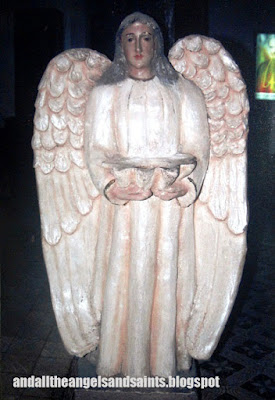By Mary Marshall
Originally
published in Archipelago, The
International Magazine of the Philippines, 1978-VI A-48. Pp. 24-26.
Bohol island is
probably most well-known in the
Philippines for its strange, humpy Chocolate Hills and its startled, saucer-eyed
tarsiers. Its mefolk too have something of a reputation. Bohol’s heroes include
fierce datus such as Warai Tupueng and Sikatuna (famous for his blood compact
with the conquistador Legaspi), Tamblot the apostate pries, and Dagoho the
outlaw and priest-killer. Not a breed to be trifled with. Nor a region where
one would expect to find the flowering of Christian folk art. Nevertheless,
some of the most remarkable churches in the Philippines are found in Bohol, and
some of the oldest.
Baclayon. The most ancient, was built by its parishioners
in 1595 to the design of Spanish priests, Juan de Torres and Gabriel Sanchez, members of the first Jesuit
mission sent to the Philippines, in 1581. Typically, it is a massive
construction made from limestone blocks hewn from the quarries of Baclayon and
neighboring Albuquerque. It stands confronting the sea, its massive three-storey tower with splayed base
resembling a fortress is not fortuitous. The belfry served as a citadel in which
parishioners could huddle for protection when Moro pirates made one of their
lightning salving raids during the seventeenth and eighteenth centuries.
The seven sacraments which correspond to the seven ages of man are also depicted in the ceiling murals.
Harassed by Moro pirates from the seas and unbelievers
from the hills, Chrstian missionaries had limited success in Bohol. The initial
impact of the Jesuit missions was confined to the coastal areas around
Baclayon, Loboc and Dauis. Even then, it seems to have been superficial as far
as most impressionable Boholanos were concerned.
In 1621,a native priest, Tamblot, incited the lowland
converts to abandon the new religion. Only Lobic and Baclayon held firm in the
new faith.Elsewhere, the renegades burnt villages and churches and built
temples to the old gods. In 1774, another, more serious rebellion broke out. When
a Spanish priest refused to give Catholic burial to a Boholano killed in a
duel, the dead man’s brother Francisco Dagohoy killed he priest and formed an
outlaw band in the hills. Many malcontents and rebels against Spanish rule
joined him and the revolt lasted nearly 100 years.
Despite the constant challenges to Christianity to Bohol
and throughout typhoons and earthquakes, the great churches of Baclayon and
Loboc survived. Other damaged churches were laboriously rebuilt or repaired
(Loboc in 1855 for instance, and Dauis in 1883). Today, the churches of
Albuquerque, Loboc, Loon and Dauis house some remarkable ceiling morals which
seem to have been first painted around the middle or later half of the last
century.
Many of the murals portray scenes from the life of
Christ, his mother and various saints, with San Roque and the Santo Niño
especially popular subjects. Sometimes, special themes are followed, such as
the Resurrection and the Ascension, or the Childhood of Christ. Sometimes,
“musical” paintings are carefully selected for the rear of the church near the
choir gallery. We see King David playing the harp, or an angelic trio of
violinist, harpist, and flautist, with a ladylike accompanist at the piano.
In Albuquerque and Loon, , the murals include a
delightful and unusual series of tableaux on the theme of the Seven Ages of
Man. The various scenes illustrate events of religious significance in man’s
life, from birth through baptism, first communion and confession, marriage,
last rites and funeral mass.
The Ages of Man murals have great appeal. The turn of the
century middle-class costumes have an evocative period flavor. In the Loon
paintings, the artist allows himself some wry humor: in the scene of the first
confession, a horned devil lies in wait outside the confessional for a girl who
clearly has been no better than she should be.
In November 1876, the river of Loboc overflowed and flooded the town to the level of the feet of the Virgin painted on the altar reredos. The townspeople implored the help of Our Lady and her intervention in stopping the flood is commemorated with ceiling paintings.
The paintings in Loboc have very local reference. In
November 1876, the waters of the river Loboc, across the street from the
church, rose during a severe typhoon to the level of the feet of the Virgin of
the church, in the reredos above the altar. At this pint, the flood waters were
stayed and gradually receded. The miracle, attributed to the Virgin, is
recalled in two of the ceiling
paintings, one a Filipino version of the biblical flood with dramatically
tumbling nipa huts.
The Bohol mural painters make no claim to be
Michelangelo, but their rk has vigor and sincerity hich endows their church
interiors with a warmth and life missinh from many more austerely or
conventionally modernized Spanish churches elsewehere. For one travel-strained
visitor least, their discovery was truly a serendipity.



























